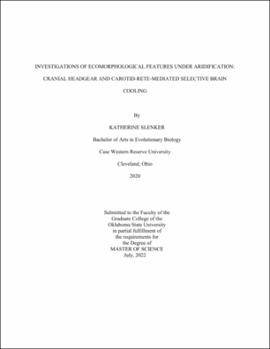| dc.description.abstract | Anthropogenic climate change presents one of the most pertinent risks to modern biodiversity. As the global climate becomes increasingly warmer and drier, it becomes equally as pertinent to understand how species respond to these shifts physiologically. To do so, we review environmental shifts throughout the Cenozoic (66 MY -present), specifically those relating to aridity – increasing environmental water scarcity – and commonly used climatic indicators for those environmental shifts, including hypsodonty and cursoriality. We then explore two additional, less-investigated potential ecomorphological traits that may correspond with environmental aridity: 1) elaborate cranial ornamentation (headgear) and 2) carotid-rete-mediated selective brain cooling. The aims of this thesis are therefore: 1) to establish a foundational description of the osteohistology of a horncore of an arid-adapted species, Antilocapra americana and 2) investigate whether carotid-rete-mediated selective brain cooling was not only selectively advantageous, but also provided a release from physiological constraint imposed by the environment, specifically aridity. I utilized standard osteohistological methods to examine the microanatomy of the horncores of both male and female Antilocapra americana, and found that these structures were composed of primarily trabecular bone tissue, supporting a role as a shock absorber in intraspecific combat. I also found evidence of reticular vascularization in the tissue surrounding the horncore, which may be indicative of a thermoregulatory function of Antilocapra americana headgear. To test for variance of δ^18O in the tooth enamel of large mammals, I completed both a non-parametric and comparative parametric analysis that compared both mean δ^18O values and δ^18O variance between species with and without a carotid retia among three environmental categories: arid, dry subhumid, and humid. The results of this analysis found that, as aridity increased the variance of δ^18O values of individuals possessing carotid retia exceeded that of those without. Concurrently, as water availability increased, variance equalized as the selective advantage of CR-SBC became less influential. Potential limitations to both of these studies are the low sample size of Antilocapra americana and the lack of carnivoran δ^18O values. | |
